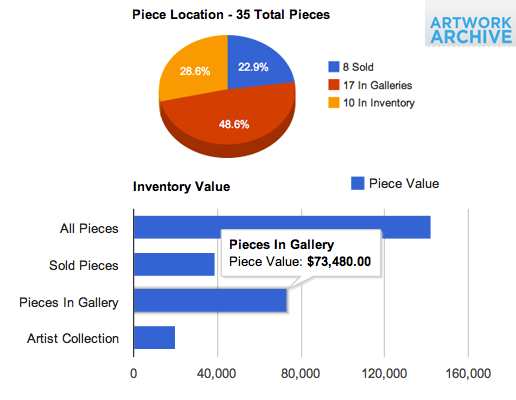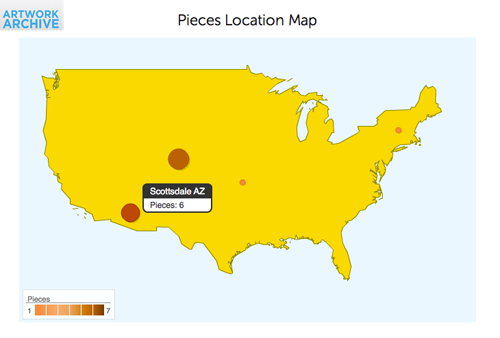Recently, I had the opportunity to sit down with the guys behind ArtworkArchive.com. They’re doing something amazing. John Feustel is a (super smart) software engineer who began building an organizational tool for his artist mother, which became ArtworkArchive. In this guest post, John talks about the need to measure and track your art activities, so you know what’s working.
What’s most important about this post to me is not the actual activity, but the fundamental mindset underlying these activities. Read on, and let us know if you track your work in the comments!
As an artist trying to build your art career you have many things to think about: networking, social media, finances, managing your contacts and sales, competitions, gallery representation, and more. It’s enough to make any artist long for the days where your only concern was the creative process. While your right brain might be screaming “just create!” your left brain knows that by organizing and taking control of your career you can achieve that most sought after goal of being able to make a living doing what you love.
In the fog of business advice, social media strategies, and financial aspects of your work, there is one area of the artist’s career that often gets overlooked. Surprisingly, it is one of the areas that is closest to the creative process and closest to what the artist does day in and day out. I’m talking about tracking, cataloguing, and archiving your work, and using this data to drive your career.
A data-driven approach
Artists that I’ve talked to have long struggled with this process. I’ve seen everything from huge spreadsheets to clunky database software to the good old pen and paper approach. Artists know that understanding the relationships between your work, sales, contacts and showings are important, yet feel burdened by old, outdated or just plain confusing tools to track these things. In a “data” driven age, advancements in technology are vital to growing your career.
How many of the following questions could you answer in 5 minutes or less?
- What is the total value of work you’ve produced in the last 6 months?
- Who are your top clients? Which galleries are they buying from?
- What is your average sale price in Gallery X vs Gallery?
- If a competition is coming up in the first week of September which of your pieces will be available to submit?
Could you answer these questions? How quickly? These are the type of things that a data-driven approach to your business can answer and in turn inform you to make educated and conscious business decisions based on all the available information.
Data for Marketing Your Work
While some of you might love the challenge of marketing your work and yourself as an artist, for many it can be one of the biggest challenges you face. Should you spend dollars on advertising or do you approach galleries and competitions to get your name out there? Determining where to put your marketing efforts can be a never ending source of confusion.
One of the key aspects to marketing yourself is knowing where your work is showing, where it’s getting bought, and what pieces are popular. Sometimes it’s just about getting the right piece in front of the right person and your art career can break wide open. While you might have a favorite piece in your collection, the public might have a completely different idea. Are you analyzing traffic to your website? Which of your pieces are getting the most views online? Which are getting shared the most through social media?
Finding not just what you like, but what fans, gallery owners, and the general public like can be the key to getting the right pieces in front of the right people.
Data for Time Management
Time management can be a powerful tool in the artist tool belt. Truly taking control of your art career requires a level of organization and time management that is overlooked by many Artists. We all only have 24 hours in a day. Should you spend your time creating new work? Should you spend your time marketing your existing work? Should you focus on competition, sales, or gallery representation?
In truth, it’s up to you how you wish to approach your art career, but whatever path you take, the ability to see what’s working and what’s not is a vital element. Set a series of small goals for each of these aspects of your career and track your progress. One big questions that many artists face is “Should I be producing more art or promoting and selling the art I already have?” While we’d all love for demand to outpace supply this is very rarely the case.
Many times artists have to take a step back from creating new work and put their efforts towards getting their current pieces seen, represented, and sold. Knowing what this balance is and where you need to spend your time can mean all the difference to your career.
Data for Sales
Ahh, sales. It can often be the most frustrating aspect of an art career. Here’s a tip, if you’re just relying on your gallery representation to do all the sales work for you then you’re selling yourself short. Potential clients love to have a direct line of communication with the artist and it is your hustle and hard work that can really propel your sales forward.
The number one tool in your sales arsenal is going to be your contact management platform. Segmenting your existing clients and potential clients, keeping notes about when to follow up and what they like, and having all their contact information at your fingertips is vital for the initial reach out, the follow up, and ultimately the sale. You don’t need to to be some hyper aggressive sales person that must “always be closing”, but equipping yourself with the proper tools and applying just the right amount of hustle can propel your art career to the next level.
Is your artwork stagnating in a certain gallery? Get it home and put it up on your wall. Maybe your next dinner guest will fall in love with it. Try out a local gallery that you wouldn’t normally put your work in. Know any local business owners? Ask them if they will display one or two of your pieces with contact information and a price below it. Tracking your work, knowing what’s moving and what’s not will enable you to make these types decisions.
Effort + Data = Success
As Henry Ford said, “There is joy in work. There is no happiness except in the realization that we have accomplished something.” As many of you know selling your first work or getting your first gallery representation is one of the best moments along this journey as an artist. The more work you put in the more and more of these moments you will have. Tracking your work and utilizing data to make decisions will not only make the effort of your career easier, but it will enable you to make smarter decisions and more informed choices. I hope I’ve proven to you that a data driven approach to your art career can help you propel your work forward and that with a little bit of effort we all can be successful doing what we love.


Sounds like a great idea. Cloudbased is still a little new–but the software seems less complicated than other software options that I have been looking at. I currently use a basic Excel file to number and keep details of each piece. I will try the free trial (thanks for making that possible by the way) and give it a try. Really sounds worth it.